

| Identification help for Garden and Common Carpets |
| .............. |
| Common and Garden Carpets may not
seem to be similar enough as to make showing the
differences between the two moths worthwhile. But to
those people new to moths and moth trapping, it can be
surprisingly easy to confuse the two. The problem lies with occasional examples of Garden Carpet, that often show a complete, or almost complete crossband on the forewings. Whilst it might not seem possible to those with many years experience (the moths do become as different as chalk and cheese eventually) the two species can be misidentified. Both are common Nottinghamshire moths, found widely across the county and both are just as likely to occur in urban and suburban light traps during their repective flight periods. In terms of population levels, our records indicate that Common Carpet is at least three times as numerous as Garden Carpet. For the purposes of identification between the two species, we have restricted the identification comparison just between the two, but there are a couple of other moths that could cause difficulties. |
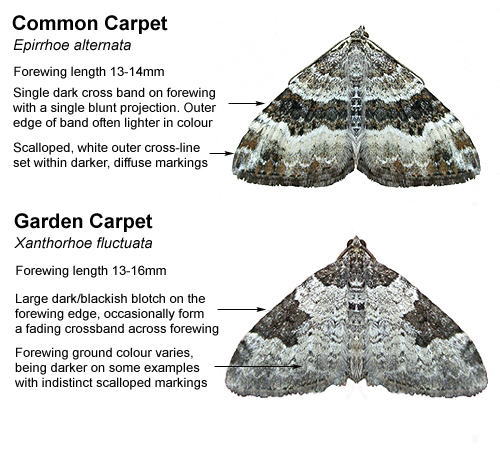 |
| .............. | ||
| In
Nottinghamshire (VC56) however, the potential for
additional confusion is limited as the similar Wood
Carpet (Epirrhoe rivata) and Galium Carpet (Epirrhoe
galiata) are both uncommon moths. The only modern
records of Wood Carpet appear to be from Sherwood Forest
CP in 1986 and the Idle Valley NR in 1995 and more
recently from Besthorpe and Misson*. Galium Carpet does
not appear to have been recorded in the county, since
moths at Sherwood Forest CP in 1987 and at Duke's Wood in
1995. *Source:- The Conservation Status of Larger Moths in Nottinghamshire - Sheila Wright, 2014 update to Third (2011) Edition. |
||
| 70.049 .... B&F 1728 .... Garden Carpet Xanthorhoe fluctuata (Linnaeus, 1758) |
Nottinghamshire status and distribution: Widespread across most of Nottinghamshire. Although we have had few records sent to us from the eastern side of the Trent Valley, there is nothing to suggest that this moth doesn't occur in the region. Garden Carpet is a common moth, which in our experience is perhaps most frequent at MV light traps operated in urban and suburban areas. Flight period: There are two broods a year, but will often be recorded from April until October. The vast majority of records occur in August and September, which can be further narrowed down to the second and third weeks of September most years. In the Spring, the first moths may be recorded in the second half of April, but numbers are higher in May and the records we have, show that there is a distinct peak around the middle of June. |
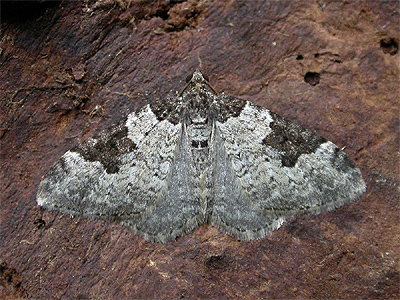 |
| .............. | ||
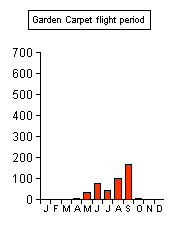 |
Identification
features: Most examples are distinctly marked
and there should be no real problem in identification.
There can be some variation in the ground-colour of the
forewings, with some examples having a more messy, darker
and less clean appearance. The most consistant feature is the dark area at the base of the forewing, which is as dark as the squarish blotch on the forewing edge. Some individuals occasionally have an almost complete cross band through the centre of the forewing, and in most cases where this is present, the band tends to narrow and fade as it approaches the edge of the wing, where it reaches the abdomen. |
|
| .............. | ||
| 70.061 .... B&F 1738 .... Common Carpet Epirrhoe alternata
(Müller, 1764) |
Nottinghamshire status and distribution: As its name would suggest, this is a common and wide-ranging moth across Nottinghamshire. Found in all habitat types, it is regularly attracted to MV light traps and equally likely in suburban gardens, as it is in rural habitats. Flight period: Common Carpet flies in an extended period from April through to September. Certainly at least two broods of adults overlap during this time, as we have found that peak numbers occur in June and then again in August, which has almost double the number of recorded individuals recorded in June. Numbers are also high during the preceding months of May and July. Identification features: The dark crossband running through the centre of the forewing, is a feature shared with several other species of Carpets not featured here. |
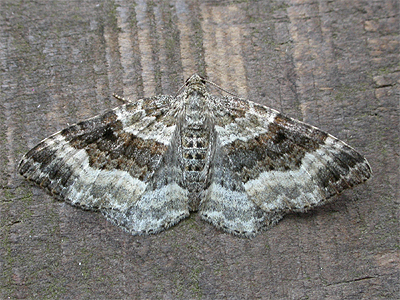 |
| .............. | ||
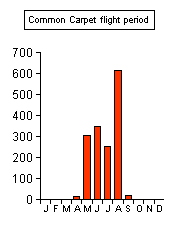 |
On Common
Carpet, the crossband is generally of a uniform width
across the forewing, but there is slight variation where
it forms a single, slight projection. The crossband fades
and wears with age and in fresh examples can be seen to
be an almost black crossband bordered by two brown bands.
There are often a series of greyish marks and scallops near the wing-tip, but these are variable and become faded or worn and the base of the forewings have a similar dark base, but this is never as dark as the same feature on Garden Carpet. Nottinghamshire (VC56) distribution Both species are found widely across the whole of Nottinghamshire. In our trapping experience, Garden Carpet is sometimes quite unusual at rural sites and does perhaps show a preference for more urban locations. |
|
| .............. | ||
| Garden Carpet Xanthorhoe fluctuata | Common Carpet Epirrhoe alternata | |
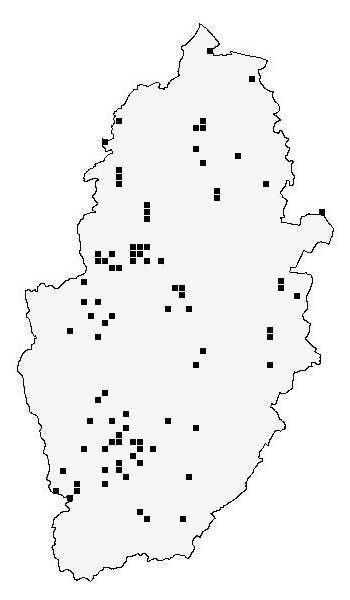 |
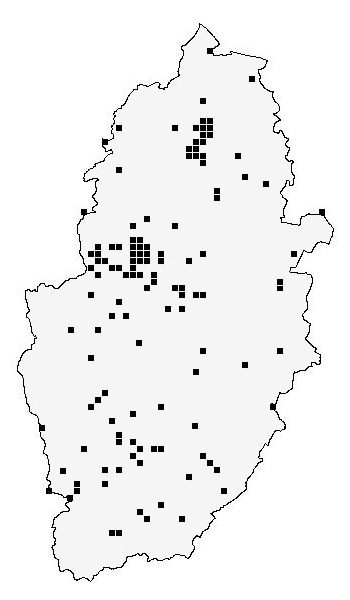 |
|